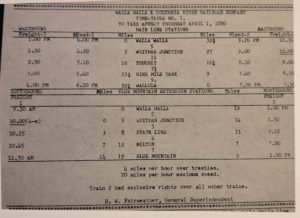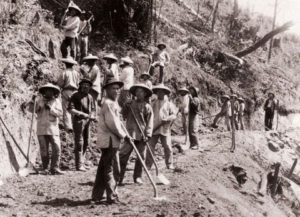Welcome to the Whitman Station on the Baker Railroad History Website
The Walla Walla and Columbia River Railroad was constructed by Dr. Dorsey S. Baker beginning in 1871 at Wallula. In 1874 when the track reached this general area, known as Whitman Station, Baker said his resources were exhausted, and sought funds from local citizens to complete the railroad to Walla Walla. It was finally completed in 1875, the first railway in the northwest other than short portage lines on the Columbia.
In 1877 Baker began preliminary work on a 14-mile extension from this point on the Walla Walla and Columbia River mainline south to the Blue Mountain Station on Dry Creek in Oregon. The Blue Mountain Extension was completed in 1879.
Though the headquarters of the Walla Walla and Columbia River line was in the city of Walla Walla, maintenance, storage, and construction of equipment all took place here, which was the final Whitman Station and featured engine sheds, car shops, a blacksmith shop, a woodshed, and a turnaround for the locomotives. The line’s December 1877 inventory included five locomotives, numerous boxcars, open cars, flat cars, passenger cars, and three handcars, with more on order.
The original site of the Whitman Station was further west where an interpretive panel describing the station is located on Old Highway 12 near a grain elevator just east of Detour Road. At that site, and also at the Frenchtown Historic Site a mile west of that, additional interpretive panels can be found, including information on the Oregon Trail and a portion of the 1855 Battle of Walla Walla between the Oregon Mounted Volunteers and warriors from various Indian Tribes.
The final Whitman Station the Blue Mountain Extension line parallels the east side of Last Chance Road. At the end of the line southwest of Milton-Freewater, the Blue Mountain Station featured a 100-foot loading dock on both sides of the tracks, and engine sheds, a car shop, a station house, a grain elevator, and a turnaround for locomotives.
Other stations on the Blue Mountain Extension line included the Baker House at Stateline about ¾ mile west of Calhounville, and Milton Station near Pleasant View School at the corner of the Old Milton Highway and Ferndale Road.
In addition to hauling grain, the Extension railroad carried wood brought down by a flume from Blalock Mountain that ended at Milton station where it dumped lumber for loading onto the railroad.
In 1878 the Oregon Steam Navigation Company bought a controlling interest in Dr. Baker’s railroad. The OSN was sold to Henry Villard in 1880, and its Oregon Railway and Navigation Company converted the Walla Walla & Columbia River mainline to standard gauge in 1881. This was necessary to connect with the new Northern Pacific line being built to the east from Portland to Wallula. The Blue Mountain Extension line was the last remaining narrow-gauge track on the Walla Walla and Columbia River Railroad.
In 1883, a portion of the Blue Mountain Extension was converted to standard gauge and connected with a line from Pendleton to Adams, Athena, Weston and Blue Mountain Station, after which the rest of the Blue Mountain Extension was abandoned.
During 1880-81, Dr. Baker began work on a separate rail line and new flume operated by his Mill Creek Flume and Manufacturing Company. For this project he hired approximately 200 Chinese laborers who camped along upper Mill Creek in an area now known as China Canyon. Other Chinese workers had been employed on the construction of Baker’s mainline and the Blue Mt. Extension.
The main 12-mile Mill Creek flume required many trestles and several cuts to reach its terminus at Dudley, now called Tracy, where the wood emptied from the flume into a reservoir, and was cut, loaded, and brought to Walla Walla on Baker’s new railroad.
In 1882, a branch of the new line was built from a point two miles below Dudley to the village of Dixie, then known as Baker City. Clay from the quarry there was shipped to the Washington territorial penitentiary in Walla Walla for brick-making, along with wheat, several other products, and passengers.
By 1890, control of the Mill Creek rail line had passed to the Oregon Rail & Navigation Company, then on to the Union Pacific, to the Northern Pacific which converted it to standard gauge, and ultimately to the Burlington Northern, which closed the line in 1970.

The Blue Mountain narrow gauge engine ran from Wallula to Walla Walla from 1878-1881, and south from Whitman Station to Blue Mountain Station in Oregon from 1881-1883.
The narrow gauge equipment that was relocated when the Blue Mountain Extension was abandoned included the Blue Mountain locomotive, which was then used on Baker’s Mill Creek line, and in 1893 was shipped by boat to the Columbia River gorge where it was put to work on the portage railroad there for 11 years. In 1906, it was sent to the Nome, Alaska gold fields to serve in mining operations.
The last run of the Blue Mountain locomotive was in 1910 in Alaska. In the 1940’s the old locomotive was submerged in the Bering Sea as part of the Nome seawall. It was eventually retrieved by a Nome resident and acquired by the Washington State Railroad Historical Society in Pasco in 1992. In 2017, it was donated to Fort Walla Walla Museum, where it is now on exhibit after nearly complete restoration.
Thanks to historian Clark Colahan for much of the information on this page, which is also found in his book, “Walla Walla’s Blue Mountain Railroad in 1879.”
Whitman Station History Panel
Additional Resources
Detecting a Ghost: The Blue Mountain Railroad in 1879
In this Museum After Hours presentation, Clark Colahan shares his story and research surrounding the uncovering of a forgotten route of the Blue Mountain Railroad. (Fort Walla Walla Museum)
Blue Mountain Locomotive: a journey comes full circle (Fort Walla Walla Museum)
Rees Garden & Mill Creek Railroad History Page
Detailed Overview of the Mill Creek Flume Railroad (UtahRails.net)
Walla Walla & Columbia River Railroad (HistoryLink.org)
Columbia Rail
Columbia Rail operates short line railroads covering 300 track miles and rail switching in five states, including the Walla Walla and Milton-Freewater areas. (ColumbiaRail.com)


